 |
 |
 |
 |
 |
 |
 |
 |
 |
 |
Home |
Edition Prints |
us: Bio/Exhibits |
Fund Raiser |
New |
Us |
Schedule |
Preservation Links |
Prints, Notecards, Posters |
covers |
 |
 |
 |
 |
 |
 |
 |
 |
 |
 |
Home |
Edition Prints |
us: Bio/Exhibits |
Fund Raiser |
New |
Us |
Schedule |
Preservation Links |
Prints, Notecards, Posters |
covers |
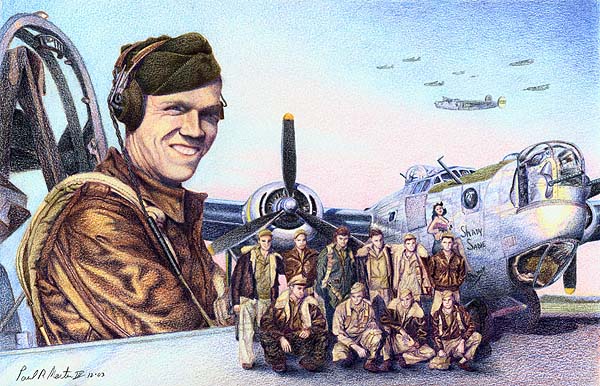 |
|
Image size 11" x 17" Release Date: April 2004 Edition Size: S/N Regular Edition of 250 Price: Regular Edition of 250: $150.00 each, Unframed  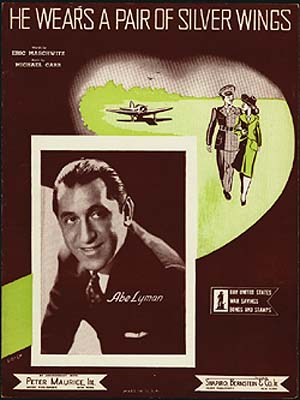
A Tribute to 1st. Lt. Edward Markewitz and the crew of “Shady Sadie” B-24-H, (HN-O) 42-95059, 446 BG, 705 BS 8th AF. To me he means a million other things For he’s the one who taught this happy heart of mine to fly HE WEARS A PAIR OF SILVER WINGS. And though it’s pretty tough, the job he does above, I wouldn’t have him change it for a king’s An ordinary fellow in the uniform I love, HE WEARS A PAIR OF SILVER WINGS. I’m so full of pride when we go walking Every time he’s home on leave, He with those wings on his tunic Me with my heart on my sleeve. But when I’m left alone and we are far apart I sometimes wonder what tomorrow brings For I adore that crazy guy who taught my happy heart To wear A PAIR OF SILVER WINGS. Copyright 1941 Words by Eric Maschwitz Music by Michael Carr   “Shady Sadie” was the oldest aircraft in the 705th Squadron. 1st. Lt. Edward Markewitz had piloted her over enemy territory on many of the 114 successful missions she completed. Based near Flixton Castle in the Village of Bungay in Suffolk County, England, the 705th was part of the 446th Bomb Group, 2nd Air Division of the 8th Air Force. With victory in Europe complete, many 8th Air Force heavy bomber crews prepared to return to the United States for B-29 training to help finish the job in the Pacific Theatre. On June 17, 1944 1st Lt. Edward “Louie da Finger” Markewitz, his air crew and ten member veteran ground crew lifted off from Shannon Ireland headed towards Lagens Field in the Azores. They had left Bungay several days earlier stopping first at Valley Wales and then Ireland before heading out again over water. Just a few hours before lifting off from Bungay, Eddy took a few moments to pen and send his wife a Western Union telegram that simply said "Dearest sweetheart, on my way home, all my love, Eddy Markewitz". Several hours out, a B-24 flying on “Shady Sadie’s” port side stalled out and plunged spiraling down into the ocean. No chutes were seen and all members were assumed to have perished. 60 minutes later “Sadie’s” no. 3 engine began to lose oil pressure and was feathered. Flying then on three engines, the plane struggled to maintain it’s altitude.  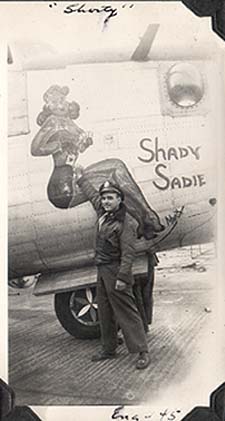 Navigator Lt. Elvyn “Shorty” de Chabert charted a course for the nearest base, an auxiliary field on the Northern Coast of Spain, some 275 miles distant. In an attempt to conserve fuel and lighten the overloaded Liberator, the crew in the waist frantically tossed every unnecessary item in the plane out the waist windows and into the sea below. Radio operator Paul W. Pifer urgently and continually tapped out S.O.S., in the hope that someone would get a fix on their location and send out rescue crews in the event they were forced to ditch in the water. He received a weak reply that to his dismay faded out immediately. Markewitz and his co-pilot, 1st. Lt. Harold H Hasselbacher, Jr., struggled to keep the plane aloft as they guided and coaxed the faltering aircraft along. Pifer picks up the story,“After what seemed an eon to twenty apprehensive crewmen, we passed over the Spanish Coast to the designated landing site, right on the button as plotted by our navigator. With total aplomb and extraordinary skill, “Louie da Finger” touched down that B-24 with a textbook 3 point landing on a rolling sheep pasture less than the length of a football field. On impact, fifteen men in the waist rushed to the tail and the craft stopped short of a copse of trees buried up to the fuselage. What a remarkable feat by our pilot and co-pilot! No one suffered a scratch!” "Shorty" de Chabert in front of "Shady Sadie"  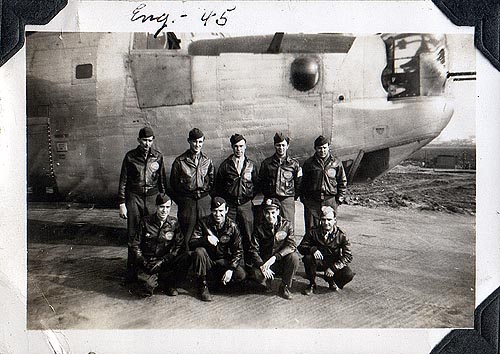 Almost immediately the crew was greeted by twelve members of the nearby Spanish garrison. Thanks to the vivacious personality and fluent Spanish tongue of Puerto Rico native “Shorty” de Chabert, the soldiers wined and dined the crew at a local Cantina with a very open bar.“Several members of the crew suffered more from the effects of Spanish Anisette and green olives on empty stomachs than from the perils of our trip.”said Pifer. The crew was transported south to Vigo for two days. By train they were moved to Madrid where they were guests at the elegant Plaza Madrid Hotel, courtesy of Senior Attaché to Spain, Col. Johnson. They enjoyed two weeks of limited R and R that included a visit to the Plaza del Toros and the Prado museum. Recalled Pifer,“An invitation by generalissimo Franco to attend a banquet in our honor at the Palace was rejected by Col. Johnson.” Eventually the men were flown back to their base at Bungay via Paris and London.  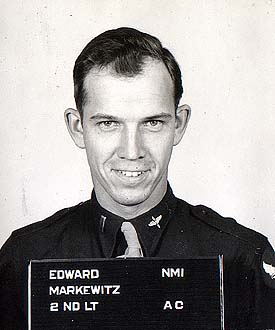
Pilot and aircraft commander, 28 year old 1st. Lt. Edward Markewitz was the “old man” of the outfit and was worshipped by the rest of the crew. He was typical of the citizen soldier who answered his country’s call in her hour of need. A first generation American, he represented the diversity of America’s ethnic background. Markewitz was born in Norwood, Massachusetts on May 24, 1917. His father and mother, Fabian and Albina Yuskas Markewitz were Lithuanian immigrants who came to America at the turn of the century. They met here in the States and Eddy and his older sister Albina spent their early years in a Lithuanian community in Massachusetts. Eddy’s dad was a housepainter and the family moved to Maspeth, Queens in 1922 when Eddy was five. He attended city public schools in Queens where he learned to speak English with a distinctive New York accent. His father passed away when young Eddy was just 13. After graduating from John Adams High School in Queens in 1935, Markewitz took a job as a tool maker at L.T. Weiss and Company in Brooklyn New York. While on the job he became good friends with a co-worker, Frank Zerilli. One day after work , Ed was invited to Frank’s home for dinner. Frank introduced him to his younger sister Mary and over dinner a romance blossomed. Mary Zarilli and Eddy were married on August 30, 1940. Eddy would write several hundred letters to is wife during his time in the Air Corps.  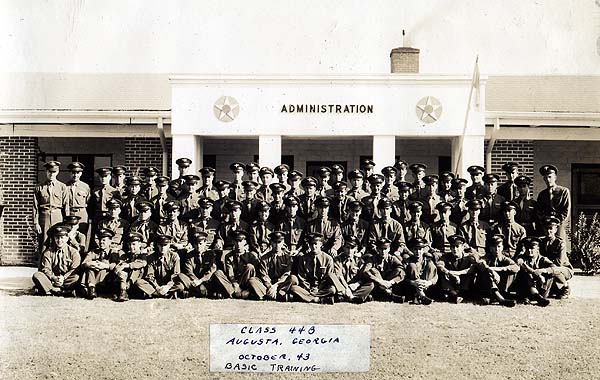 Markewitz attended City College for two years while he continued to work at Weiss and Co. through the early years of WWII, but in late 1942 he felt the strong pull of patriotism and volunteered for military service. He enlisted in the Army Air Corps on November 27 of that year. He was given some time to get his personal effects in order, then reported for active duty and basic training on January 28, 1943. Markewitz learned to fly an airplane at Bush Field, Augusta, Georgia and completed his advanced flying training at Moody Field in Valdosta, Georgia. He was assigned to and completed B-24 pilot’s training. After flight crew assignment and final training, he and his new nine man crew departed for the European Theatre on October 10, 1944. The six foot tall, blue eyed Lt. Markewitz was immediately liked and respected by those who entrusted their lives to him. They affectionately nicknamed him “Louie da Finger” after a well known New York hood, whom Eddy could mimic in his own perfect New York accent.  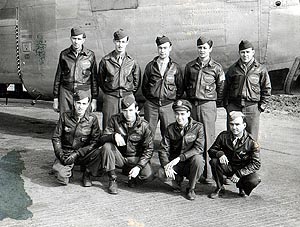 The other crew members were; Radio Op, Paul W. Pifer, Nose Gunner David Hensley, Co-pilot, 1st. lt. Harold H Hasselbacher, Jr., navigatoer, 1st Lt. Elvyn de Chabert, Engineer, John J. Coughlin, Jr. and gunners, Wilfred P. Crofts, Martin W. Madden, James E. Pitts, Henry W. Huetten and Warren W. Wood.  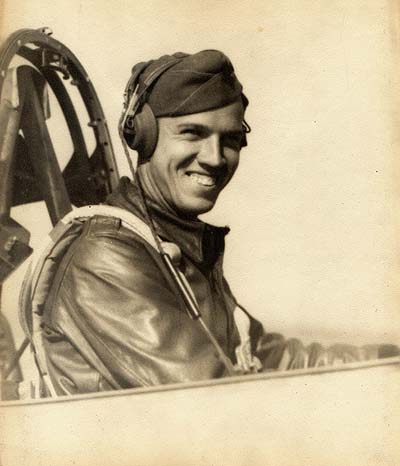
The crew was assigned to the 705th Squadron of the 446th Bomb Group, 8th Air Force; “The Bungay Buckaroos” . After their fourth mission Eddy would write home. Somewhere in England, Dec. 3, 1944 Dearest Sweetheart, I love you...I'm not writing you very regularly, honey. Sometimes a couple of days in a row, sometimes every other day, sometimes not for several days. It isn't that I've forgotten you, or I am merely neglecting you. It's just that that's how it is when I fly a combat mission (I’ve got four now) I can't write. I take my whiskey (they give us a terrific shot, about half a tumbler, on an empty stomach) and crawl into my sack and try to forget what it's like to see my comrades killed. See what I mean?...  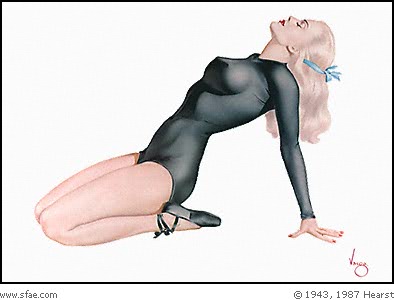 Lt. Markewitz and crew didn’t have their own Liberator, instead they would fly whatever aircraft was available when they were assigned to a mission. Markewitz hoped they would get their own plane one day as he would refer to in a letter to Mary in early December. Somewhere in England, Dec. 8, 1944 Dearest Sweetheart, I love you...I haven't got a ship of my own, flying everyone else's. "Dirty Deed", "Shady Sadie", "Umbriago". No "cupcakes" yet. We've got a Rembrandt all lined up to do the painting for us. He's very good. We have a Varga model. You may have seen it. A gal sitting on her heels, hands behind her, head back, cupcakes out.... Here is an image of the Varga Girl Markawitz was probably alluding to. She was the centerfold of the June 1943 issue of Esquire magazine.  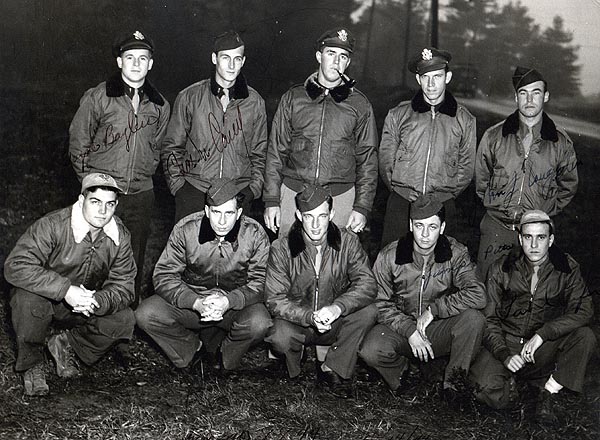 From their home base Lt. Markewitz would lead the men on 30 missions. Two memorable missions stand out amongst all the others. It was a typical English dawn on New Years Day 1945; cold, gray and miserable . The crew was awakened at 3:00 AM. Pifer remembered that,“Following the usual insipid breakfast of powdered eggs and spam, we gathered in the briefing room for details of our impending mission over Germany. I had become nineteen years old less than a month before.” When the curtain was drawn back from over the briefing room map, the town of Andernach was revealed as the designated target. Markewitz and crew would be flying “Battle Dragon” that day. (B-24H 42-50431, 705 Sq, HN-R) Clear weather and minimal flak were predicted over the target. Two extra crewmen were assigned to the regular crew that morning. James Tootell and Richard Du Bois were trying to make up their 34th mission so they could fly their last, number 35 with their regular crew. Tootell would be the flight engineer and Dubois the radio operator for the mission so Pifer went along as waist observer.  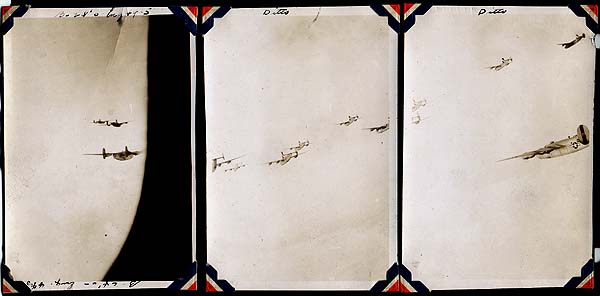 “Battle Dragon” reached the IP in group formation over the small medieval town of Trier, Germany. A second directional bearing was needed for the target so the group circled around, flying back above Trier. Three flak guns below opened up again on the second pass. Flying directly through the black, smoky bursts, the aircraft shook and quivered from the deadly explosions. Suddenly the plane rocked violently. A direct hit had shot the number three engine off its mounting. Fuel spilled out, streaming across the starboard wing creating an extremely volatile fire hazard. Markewitz aborted the mission and headed southwest. The bomb load was dumped over a nearby forest impacting in a non populated area and doing little damage. The crew secured their parachute harnesses and waited for the bail out signal. At 22,000 feet the fuel gauges showed empty and the order was given to jump. Markewitz held the plane steady as each member of the crew bailed out. After everyone else was clear of the ship, but before he leaped, Pifer called the pilot over the intercom and reported that the waist was clear and that he was jumping. Markewitz responded with“Good luck, I’ll see you down below kid.”  
Pifer continued, “On leaving the aircraft, I righted myself, counted ten seconds because of the altitude and pulled the rip cord. Nothing happened! Probably instinct prompted me to clutch at the flap of my chestpack. After what seemed like an interminable lapse of time, the pilot chute blossomed forth past my face and then the main chute opened with a tremendous jerk on my body. I experienced exquisite right groin pain and nearly fainted. This was caused by carelessness on my part, a loose harness strap. However it was good to be alive and I silently gave thanks to the Lord. I became aware of the B-24 spiraling around me in tight concentric circles, constantly losing altitude, its engines silent. A parachute opened above me. The aircraft continued to drop and finally crashed and exploded in flames on the side of a small wooded hill.” Pifer landed in a harvested cornfield. He was still in pain and had difficulty spilling his chute which dragged him across a row of sharp 8 inch corn stalks. Finally the wind died down enough to enable him to corral and fold the chute. Pifer stood up and freed himself from the harness which immediately eleviated some of his pain. He saw Lt. Markewitz touch down about one-hundred yards away and they quickly joined each other in the field. Shortly they were joined by several of the other crew members who had also landed near by. They lighted cigarettes and started to plan their next move, not sure if they were in liberated France or enemy occupied territory.  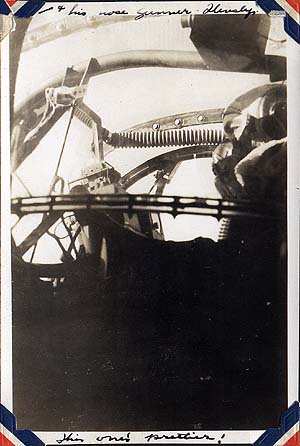 Before they had time to react they were surrounded by several heavily armed civilians, who, fortunately for the crewmen, turned out to be Free French resistance fighters. They had come down near the village of St. Blin. Soon it was discovered that their nose-gunner, David Hensley was killed on impact when his chute didn’t open. As they compared notes it seemed that four of them had experienced the same failed chute opening when they first pulled the ripcord. The mission navigator sustained crush fractures in his right heel and Pifer had a partial fracture of his right pubic bone. They were both taken to the 23rd General Hospital in Vittel which had been a hotel and was converted by the Army. The navigator was returned to the States for his injuries but Pifer’s injury was deemed mild enough for him to return to his crew at Bungay. Back at Bungay during de-briefing, it was determined that the chutes had failed because they had frozen at the extreme altitude. (Right) Nose Gunner, David Hensley in his turret over enemy territory.  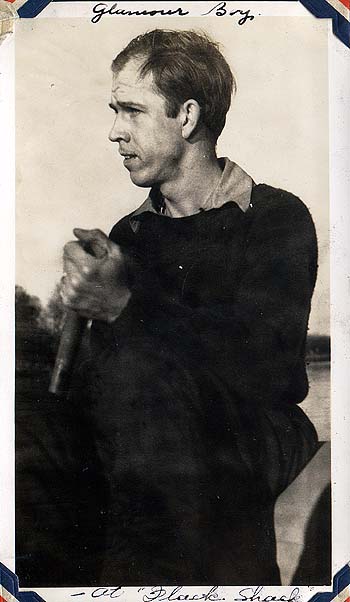 Somewhere in England, 1 February, 1945 Dearest Sweetheart, I love you....."I'm in sad shape today. I'm filthy, I need a shave. There's no water on the post. The electricity just went out, killing the radio, the fire is out, and while there's still some coal there's no wood, so things are getting rough in the ETO.....I don't remember if I ever told you how many missions we fly for a tour, anyway. I'm not supposed to, so if I haven't I won't. I don't think I'll tell you how many missions I've got either. There's no use your sweating them out too. I've got the air medal and a cluster for it, that's all I'll say...  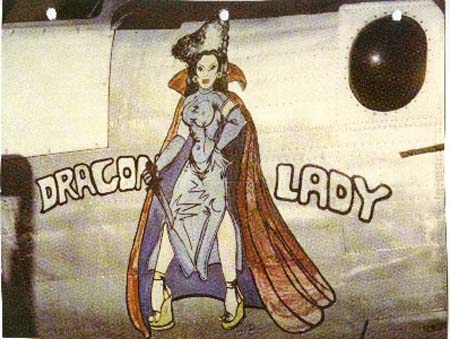
Rare color photo of “Dragon Lady” B-24J 42-50306 706 SQ RT-S that landed at a fighter base near Toul France on 2- 25-45 coming back from a raid on Aschaffenburg. Courtesy of crew chief and nose art artist, Harry Gerrish. On February 25, 1945 the crew would fly a mission in the “Dragon Lady”. ” (B-24J 42-50306 706 SQ RT-S) They were part of a large 2nd Air Division raid of 169 B-24’s assigned to attack a marshalling yard and tank factory at Aschaffenburg. During the bomb run over Aschaffenburg they were struck by flak and were forced to feather the no. 2 engine. Markewitz would skillfully fly the damaged aircraft back to France where he landed the big bird safely at a forward fighter base near Toul. March 13, 1945, Dearest Sweetheart, I love you...Spring is here! It's a beautiful day. The sun is shining in a cloudless sky. The air is warm and laden with the scent of newly turned earth, that promises bright spring flowers. Birds fill the morning air with their incessant chattering...And the fresh new grass lazily pushes aside the brown blanket of earth. And the great stately trees have their hair pinned up in tight little buds, preparatory to combing it out in bright foliage, decked with flowers. The earth yawns, stretches, and wakens to spring's gentle call. And the eternal magic of that perennial renaissance never fails to stir me. Well, well. I wax poetic. In the spring a young man's fancy...Gee, I wish you were here with me! You'd see just how poetic I could wax. I love you. The beauty of these meadows and green hills is lost without you. A setting without a gem. But then, wherever you are, you shed beauty like a soft light, to make even the most desolate spot respondent in your reflected glory. Or do you suppose I'm just in love with you?...  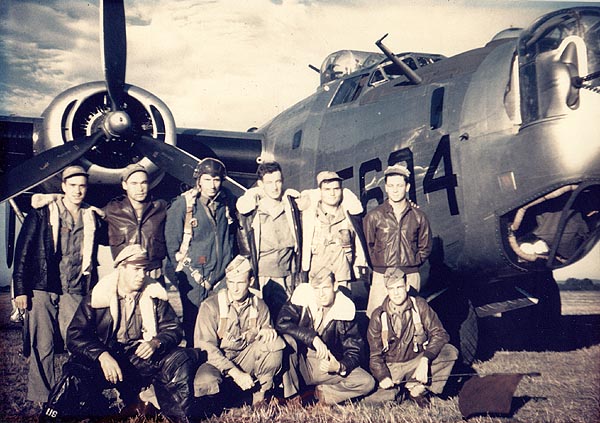 June 27, 1945 Back in Bungay Dearest Sweetheart, I love you...We got back to the base yesterday. Two weeks ago we climbed aboard Shady Sadie and kissed this place good-bye. I thought. A matter of about twenty hours more and I'd have been back in the States but noooo! Every time I get out on the Atlantic ocean about half way between here and nowhere I lose and engine! Well, now I quit. They asked me over at ATC headquarters how I wanted to get home now, pick up another plane or what. Shorty, Harry, John, Paul and I were in the office. In unison we told him "BY BOAT!"... They did return to the States “BY BOAT”, aboard the Queen Mary with the rest of the 446th ground personnel, supposedly the last combat crew from the group to return home. They arrived in New York Harbor on July 11, 1945.  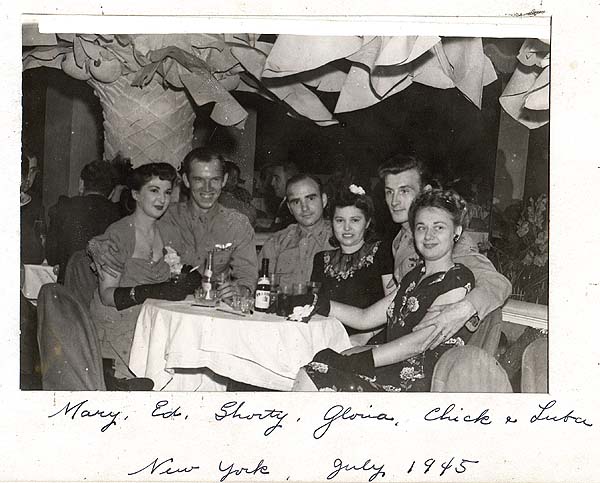 Pifer would attend college thanks to the G.I. Bill and would become a doctor. “Shorty” de Chabert returned to his native Puerto Rico where he became a successful manufacturer’s representative. Lt. Eddy Markewitz would never fly or travel by air again. He was honorably discharged on October 6, 1945, and returned to Queens NY. Eddy became Clerk-of-Courts in Nassau County, NY. Later, he and Mary would move to East Meadow on Long Island, NY, where they bought a home and raised one child in postwar suburban bliss. Eddy passed away unexpectedly from a heart attack on October 21, 1970. He was just 53 years old. Raising families and getting on with their lives after the war left little time for re-unions. Regular letter writing, Christmas cards and phone calls kept the men in contact with each other. Occasionally two or three would get together at one’s home for a few days to reminisce about their wartime experiences. During one of Dr. Pifer’s visits to Gloria and “Shorty” de Chabert’s home in Puerto Rico in the 1980’s, “Shorty” ensured Pifer that“The skeleton of ‘Shady Sadie’ still rests in that sheep pasture in Northern Spain!” The crew had flown thirty combat missions during 200 combat hours above dangerous German occupied Europe. Day after day they carried the fight to the heart of the Nazi Regime and played an integral role in the final defeat of Hitler and the Axis nightmare. For their service to our country they would earn the Distinguished Flying Cross, Air Medal with Four Oak Leaf Clusters and the European, African, Middle Eastern Ribbon with two Battle Stars. Similar to most US Soldiers during WWII, their survivalist instincts forged during the great depression blessed them with an indomitable resiliency and “can do” attitude, typical of “the spirit of American youth" that shone across so many battlefields. The people of America and citizens of the free world owe them all a sincere debt of gratitude. “He Wears A Pair Of Silver Wings” is respectfully dedicated to Lt. Edward Markewitz and the crew of “Shady Sadie” , who along with their compatriots in the 446th Bomb group, and the rest of the 8th Air Force, “did nothing less than save the world!” Special thanks to Donna Buckalter, daughter of Eddy Markewitz. Bob Livingstone. Harry Gerrish and all at http://www.b24bestweb.com Click Here to view MORE photos from Lt. Markewitz's Personal Wartime Album  Martkewitz, Edward, personal effects, letters, documents, photos. Pifer, Dr. Paul W., “The Indelible Event” Northshore Magazine, December 1984 Freeman, Roger A., The Consolidated B-24J Liberator. Profile Publications # 19, Surrey, England, 1965 Forman, Wallace R., B-24 Nose Art Directory. Specialty Press Publishers, Phalanx Publishing, North branch, MN. 1996 Davis, Larry. B-24 Liberator in Action. Squadron/Signal Publications Inc. Carrollton, TX, 1987 p 34. Birdsall, Steve, Log of the Liberators, Doubleday and Company Inc., Garden City, NY 1973, p. 161 Bowman, Martin W. Fields Of Little America. An Illustrated History of the 8th Air Force 2nd Air division 1942-45 Patrick Stevens Limited, Bar Hill, Cambridge, GB., 1983 Munday, E. A and Ward, Richard, USAAF Heavy Bomb Group Markings and Camouflage 1941-1945 Consolidated B-24 Liberator, Osprey Publishing Limited, Kent, England, 1972 Dorr, Robert F., B-24 Liberator Units of the Eighth Air Force, Osprey Publishing Limited, Kent, England, 1999 Freeman, Roger, E. The Mighty Eighth, A History of the US 8th Army Air Force, Doubleday and Company, Inc., Garden City, NY, 1970 Bailey, Mike and North, Tony, Liberator Album: B-24’s of the 2nd Air Division USAAF, Midland Publishing Limited, Leicester, England, 1998 Anderson, Christopher, J., The men of the Mighty Eighth: The US Eighth Air Force, 1942-1945, Stackpole Books, Mechanicsburg, PA, 2001 Rust, Kenn, C., Eighth Air Force Story, Sunshine House, Terra haute, IN, 1978 Hammel, Eric, Air War Europa; America’s Air War Against Germany in Europe and North Africa, Chronology, 1942-1945, Pacifica Press, Pacifica CA, 1994 Click Here to view MORE photos from Lt. Markewitz's Personal Wartime Album  AMERICAN BEAUTY 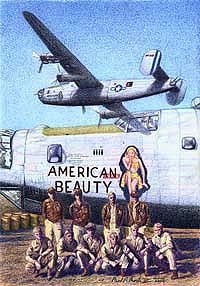 "American Beauty" B-24J 44-41251 14 AF, 308 BG, 375 SQ, CBI Image size 8" x 11" Release Date: April 2002 Edition Size: S/N Regular Edition of 308 Price: Regular Edition of 308: $80.00 each, Unframed   Visit the 446th Bomb Group website by "clicking" on the icon above. Visit B-24BestWeb the best ALL B-24 site on the net. NEW!: Paul Martin's Tribute to POCO MOCO B-24J, 44-49451 14th AF, 308th BG, 375th BS Click Here to view MORE photos from Lt. Markewitz's Personal Wartime Album | silver wings2 | silver wings3 | | American Beauty | AmericanBeauty2 | So Gallantly Streaming | silver wings | | Gettysburg Series | Great American Portrait Series | WWII Series | Revolutionary War Series | Civil War Series | West Point Series | Banners Of Glory Series | | Return Home | Limited Edition Prints | About us: Bio/Exhibits | 9-11 Fund Raiser | What's New | Contact Us | Events Schedule | Friends- Preservation Links | Mini Prints, Notecards, Posters | book covers | |
||
